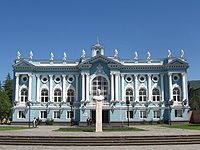
Architecture of Georgia (country)
Encyclopedia
The Architecture of Georgia refers to a style of architecture found in Georgia
.
Georgian architecture is influenced by a number of architectural styles, including several each for castles, towers, fortifications and churches. The Upper Svaneti
fortifications and the castle town of Shatili
in Khevsureti
are among the finest examples of medieval Georgian castles.
Georgian ecclesiastic art represents one of the most fascinating aspects of Georgian Christian architecture, combining classical dome
style with original basilica
style. Often known as the "Georgian cross-dome style," this style of architecture developed in Georgia during the 9th century. Before that, most Georgian churches were basilicas. One distinguishing feature of Georgian of Georgian ecclesiastical architecture, one which can be traced back to a high emphasis on individualism
in Georgian culture, is reflected in the allocation of space inside the churches. Other examples of Georgian ecclesiastic architecture can be found overseas, in Bulgaria (Bachkovo Monastery
built in 1083 by Georgian military commander Grigorii Bakuriani), in Greece (Iviron monastery
built by Georgians in 10th century) and in Jerusalem (Monastery of the Cross
built by Georgians in 9th century).
 Other architectural styles in Georgia include the Hausmannized
Other architectural styles in Georgia include the Hausmannized
Rustaveli Avenue in Tbilisi
and that city's Old Town District.
Georgia (country)
Georgia is a sovereign state in the Caucasus region of Eurasia. Located at the crossroads of Western Asia and Eastern Europe, it is bounded to the west by the Black Sea, to the north by Russia, to the southwest by Turkey, to the south by Armenia, and to the southeast by Azerbaijan. The capital of...
.
Georgian architecture is influenced by a number of architectural styles, including several each for castles, towers, fortifications and churches. The Upper Svaneti
Svaneti
Svaneti is a historic province in Georgia, in the northwestern part of the country. It is inhabited by the Svans, a geographic subgroup of the Georgians.- Geography :...
fortifications and the castle town of Shatili
Shatili
Shatili is a historic highland village in Georgia, near the border with Chechnya. It is located on the northern slope of the Greater Caucasus mountains, in the historical Georgian province of Upper Khevsureti, which is now part of the modern-day region of Mtskheta-Mtianeti.-Geography:Located in...
in Khevsureti
Khevsureti
Khevsureti/Khevsuria is a historical-ethnographic region in eastern Georgia. They are the branch of Kartvelian people located along both the northern and southern slopes of the Great Caucasus...
are among the finest examples of medieval Georgian castles.
Georgian ecclesiastic art represents one of the most fascinating aspects of Georgian Christian architecture, combining classical dome
Dome
A dome is a structural element of architecture that resembles the hollow upper half of a sphere. Dome structures made of various materials have a long architectural lineage extending into prehistory....
style with original basilica
Basilica
The Latin word basilica , was originally used to describe a Roman public building, usually located in the forum of a Roman town. Public basilicas began to appear in Hellenistic cities in the 2nd century BC.The term was also applied to buildings used for religious purposes...
style. Often known as the "Georgian cross-dome style," this style of architecture developed in Georgia during the 9th century. Before that, most Georgian churches were basilicas. One distinguishing feature of Georgian of Georgian ecclesiastical architecture, one which can be traced back to a high emphasis on individualism
Individualism
Individualism is the moral stance, political philosophy, ideology, or social outlook that stresses "the moral worth of the individual". Individualists promote the exercise of one's goals and desires and so value independence and self-reliance while opposing most external interference upon one's own...
in Georgian culture, is reflected in the allocation of space inside the churches. Other examples of Georgian ecclesiastic architecture can be found overseas, in Bulgaria (Bachkovo Monastery
Bachkovo Monastery
The Bachkovo Monastery , archaically the Petritsoni Monastery or Monastery of the Mother of God Petritzonitissa in Bulgaria is an important monument of Christian architecture and one of the largest and oldest Eastern Orthodox monasteries in Europe...
built in 1083 by Georgian military commander Grigorii Bakuriani), in Greece (Iviron monastery
Iviron monastery
Holy Monastery of Iviron is an Eastern Orthodox monastery at the monastic state of Mount Athos in Greece...
built by Georgians in 10th century) and in Jerusalem (Monastery of the Cross
Monastery of the Cross
The Monastery of the Cross is a monastery near the Nayot neighborhood of Jerusalem, Israel. It is located in the Valley of the Cross, below the Israel Museum and the Knesset.- History :...
built by Georgians in 9th century).

Baron Haussmann
Georges-Eugène Haussmann, commonly known as Baron Haussmann , was a French civic planner whose name is associated with the rebuilding of Paris...
Rustaveli Avenue in Tbilisi
Tbilisi
Tbilisi is the capital and the largest city of Georgia, lying on the banks of the Mt'k'vari River. The name is derived from an early Georgian form T'pilisi and it was officially known as Tiflis until 1936...
and that city's Old Town District.

